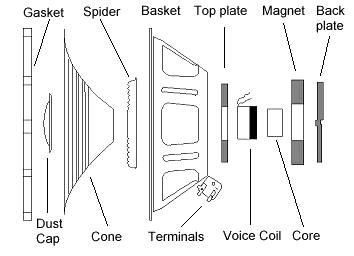Blog, Technically Speaking
How a Speaker works detailed
The key working components of a loudspeaker are shown in the diagram below. When an electrical
current passes through a wire coil (the voice coil) in a magnetic field, it produces a force which varies with the
current applied. The cone, connected to the voice coil, moves in and out, creating waves of high and low air
pressure.
The coil and magnet assembly are the ‘motor structure’ of the loudspeaker. The movement is controlled by the loudspeaker’s suspension which comprises the cone surround and the ‘spider’. The surround and spider allow
the coil to move freely along the axis of the magnet’s core (or ‘pole’) without touching the sides of the magnetic
gap.
Eminence technology and proprietary materials mean that age-old ‘compromises’ of durability against sensitivity,
or power handling against precision of response, are more easily solved than you might imagine.
Heatsinks: In the quest for higher power density (more power and hence more sound from less space),
Eminence has progressively introduced heatsink components to selected transducers e.g. cast frame neodymium products and Kilomax. The heatsinks pass through the pole of the transducer or are incorporated into the chassis
of the loudspeaker to transfer heat away from the coil. The air currents caused by the cone movement cool the heatsink.
(from Eminence Speaker)


